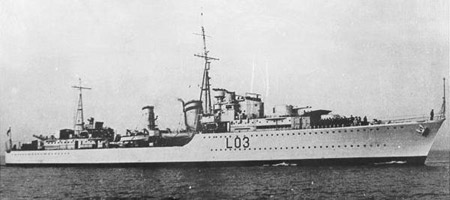I Was There! - We Didn't Bother About the 'Graf Spee'
The War Illustrated, Volume 2, No. 24, Page 125-126, February 16, 1940.
Accounts of the Battle of the River Plate by British prisoners on board the "Admiral Graf Spee" were given in page 541, but the first eye-witness stories by participants in the action were told when the "Ajax" returned to Plymouth on January 31. The following account is reprinted by arrangement with "The Times".
An officer of the "Ajax" explained that before the action it was not definitely known that the "Admiral Graf Spee" was in those waters, but it had been calculated that if she was heading for South America she would be somewhere in their proximity about 150 from the coast just about that time. The calculations proved remarkably accurate, and she was sighted about 6 o'clock on the morning of December 13.
"The 'Exeter' was about one and a half miles away from us at the time", he said, "and the 'Achilles' was also within close range. We thought at the time that the 'Graf Spee' probably first spotted the top of the tall masts of the 'Exeter' and assumed that there was only one cruiser to tackle. She soon found, however, that there were three of us, and she opened fire simultaneously on the 'Exeter' and ourselves. But within a few minutes she began to concentrate her main armament of 11-inch guns on the 'Exeter', and with these her firing at first was extremely accurate. Meanwhile, she turned her secondary armament of four 5.9 guns on us, but with those she was not so accurate. Occasionally she turned on us with salvoes from the heavy guns, but generally she reserved these for the 'Exeter', and it was a regular dog fight.
"The 'Exeter' dropped out of the action after 50 minutes and it was not for another 31 minutes that the action was broken off. All the time the 'Graf Spee', which was using a smoke screen continuously, was trying to get away, but we were a little faster and gradually we closed the distance between us. As soon as the 'Exeter' dropped out of the action the 'Graf Spee' concentrated on us, but with the 'Achilles' we closed in at breakneck speed at a range of 9,000 yards. We fired four torpedoes and the 'Exeter' had previously fired six. The 'Graf Spee' also fired four at us, but all 14 missed their mark. As soon as the 'Graf Spee' saw our torpedoes she altered course 150 degrees, and that was the beginning of the chase.
"We continued to shadow her all day until she ran into Montevideo at 10 o'clock at night. During the action our one aircraft did some valuable spotting work, but she did not attack the 'Admiral Graf Spee'. She is, in fact, only a spotting machine. Once she went near the 'Admiral Graf Spee' and got some shrapnel through her wing, but she still carried on with her job."
The officer went on to explain that while they were waiting outside Montevideo they were told the 'Admiral Graf Spee' was preparing to leave, and the members of the crew of the 'Ajax' seemed desperately keen to have another crack at her."
Able-Seaman Lancelot Jacques, aged 19, one of the youngest of the "Ajax" company, said that when they knew they were up against the "Admiral Graf Spee" "we didn't bother at all", and he added that during a lull in the action two members of his gun's crew played mouth organs.
Another seaman, who was wounded in the leg, also said that while he was standing by an anti-aircraft gun, which did not need to go into action, the members of his crew sang "Roll out the Barrel" and other popular songs while shells dropped in the sea around them.
Previous and next article from The Battle of the River Plate
I Was There! - Our Ships were Sunk by the 'Graf Spee'
Only after the sinking of the "Graf Spee" was it clear that it was she, and not the "Admiral Scheer", which sank the "Clement" (see page 382) and the "Africa Shell". A later story of the sinking of th
The Nazi Slave-Ship Feels the Nelson Touch
Yet another dramatic chapter in the history of the British Navy was written when on February 16 H.M.S. "Cossack" pursued the Nazi slave-ship "Altmark" into a Norwegian fjord and rescued 299 British pr
Previous and next article from I Was There!
I Was There! - Our Ships were Sunk by the 'Graf Spee'
Only after the sinking of the "Graf Spee" was it clear that it was she, and not the "Admiral Scheer", which sank the "Clement" (see page 382) and the "Africa Shell". A later story of the sinking of th
I Was There! - We Scored a Direct Hit on a U-Boat
On March 13 the Air Ministry announced that during a reconnaissance flight over Heligoland an R.A.F. bomber had successfully attacked a German submarine at the entrance to the Schillig Roads. A brief
Index
Previous article
I Was There! - Our Ships were Sunk by the 'Graf Spee'
Only after the sinking of the "Graf Spee" was it clear that it was she, and not the "Admiral Scheer", which sank the "Clement" (see page 382) and the "Africa Shell". A later story of the sinking of th
Next article
The Cheerful Civilian
Should a bomb drop upon my Civil head It kills no Soldier. Why then, let it chance! At least I'll smile to think, when I am dead, It might have killed ten men "somewhere in France". I should tak




